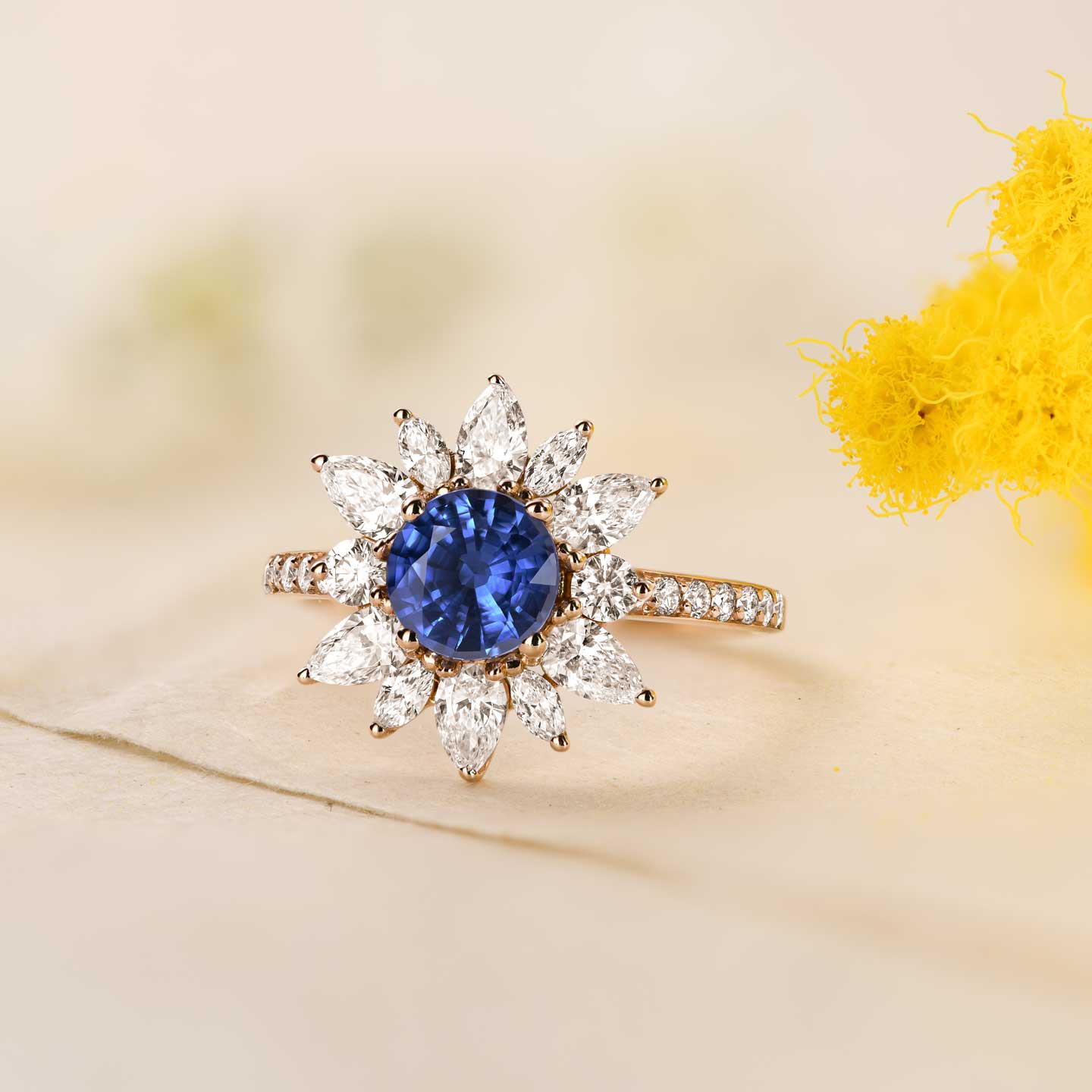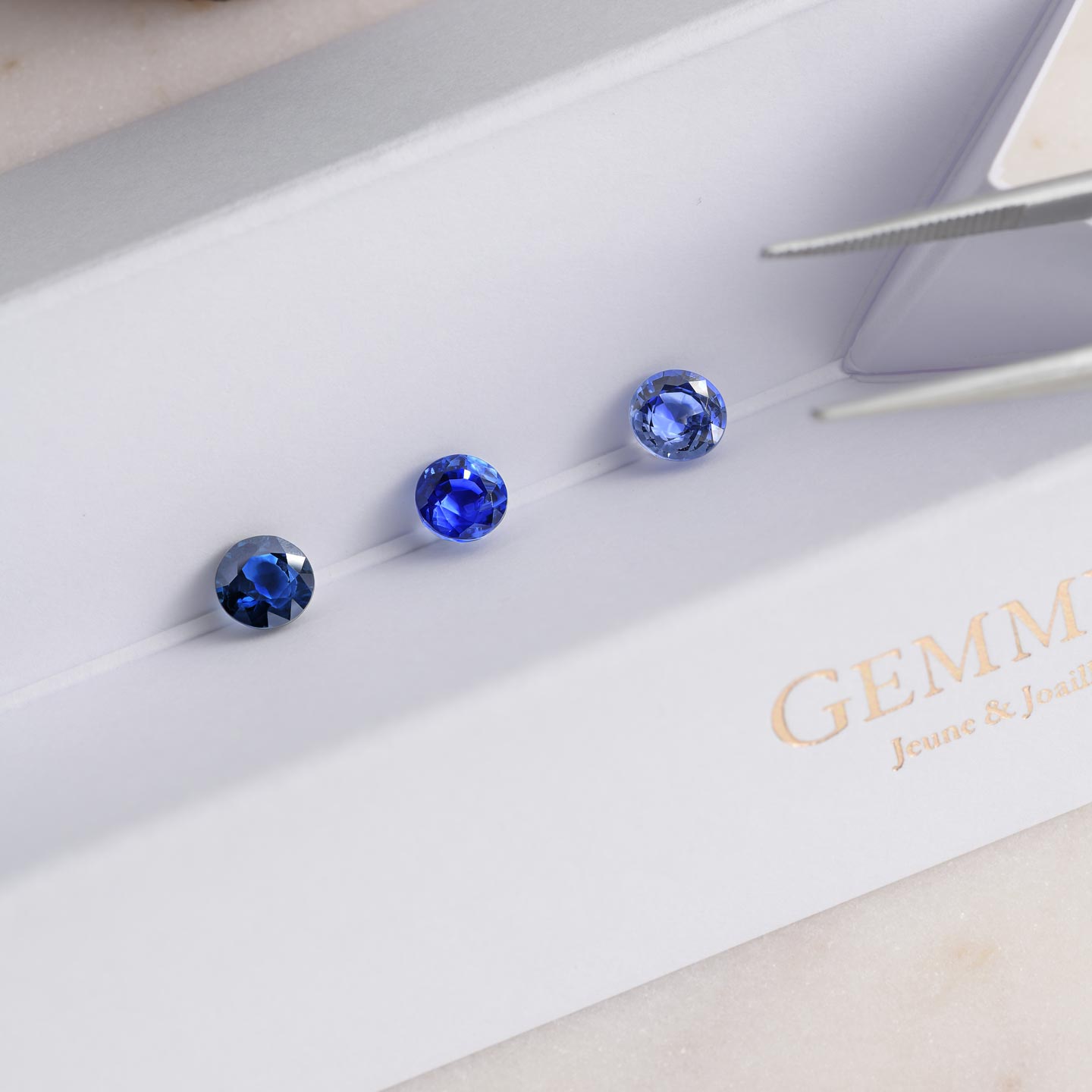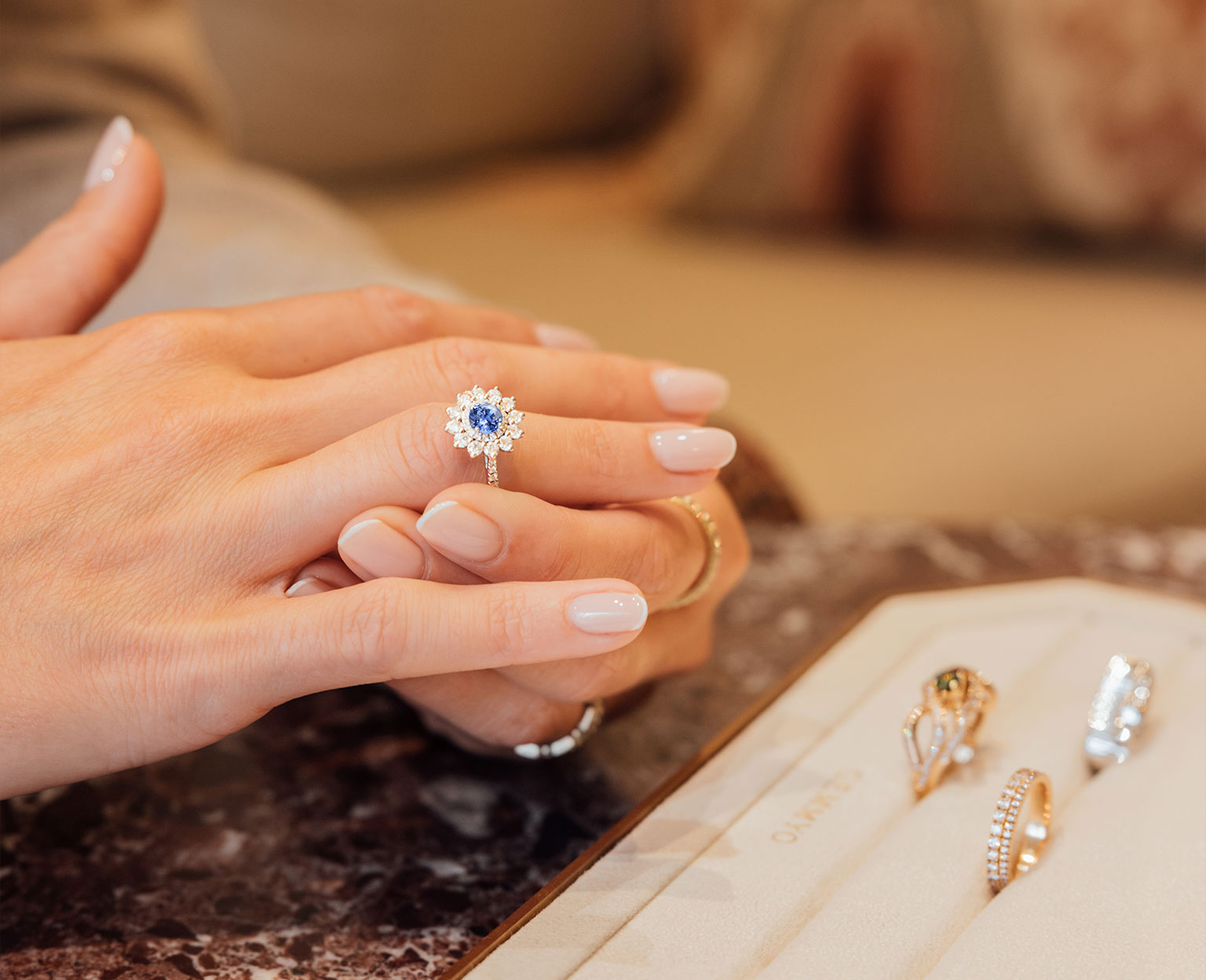Sapphire is one of the most iconic stones in the jewelry world. For most of us, it is what first comes to mind when we think of coloured stones! Its deep blue colour has made it famous throughout the centuries.
Is it suitable for everyday wear such as an engagement ring? What are the differences with other coloured stones? Can we choose the colour of the sapphire directly on the website? What are its different qualities?
These are common questions that we will answer in this guide to one of the most important stones in jewelry!
Before going into detail, let's first look at its history and origins.
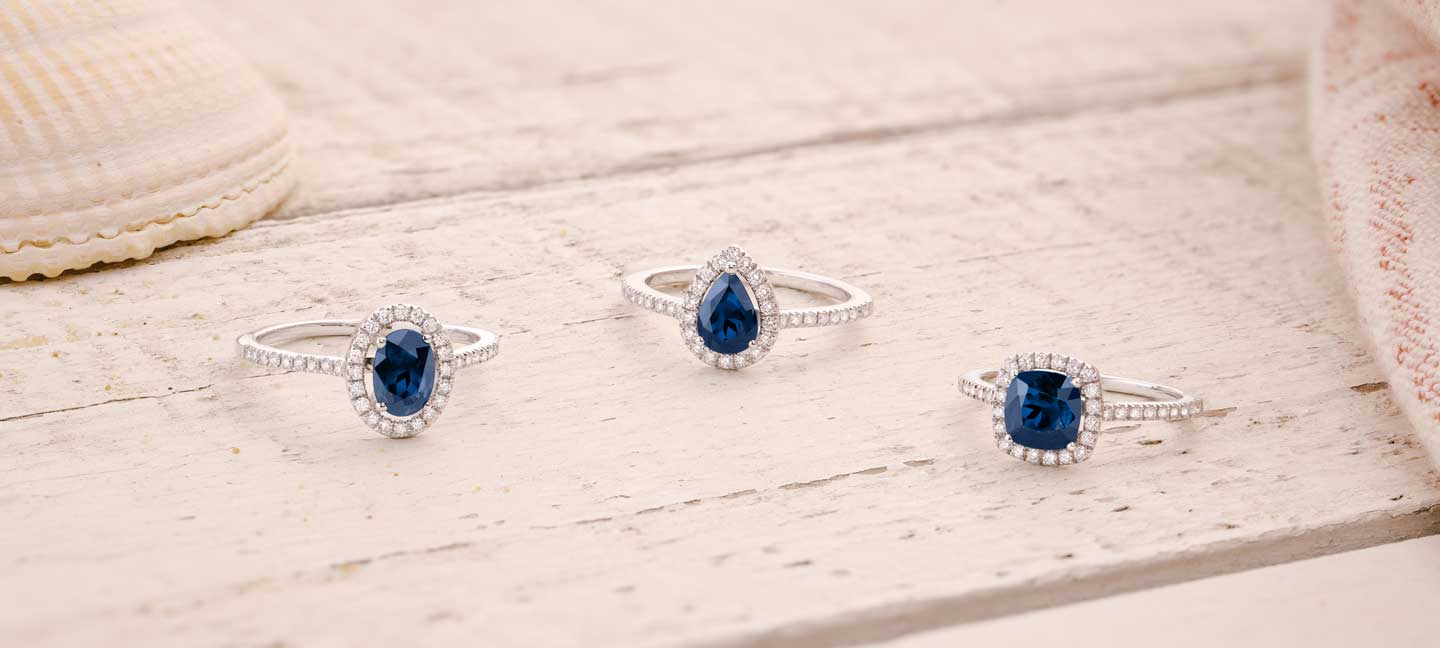
The history of sapphire
The name sapphire comes from the Greek word Sappheiros which means blue. Its use in commerce is very old and stones from Sri Lanka were already used by the Romans in the 5th century BC.
As with most gemstones, sapphire was early associated with symbols, the Romans, like the Egyptians, associated this sacred stone with truth and justice.
For the Persians, its colour reminded them of the reflections of the sky. Later, it was the monarchs and the Catholic Church who appropriated it and used it on jewelry as a symbol of purity and of their link with the divine.
Our traditions have evolved over time and today this stone has become a symbol of fidelity, one of the reasons why it is often set on an engagement ring! The most famous of these is certainly Princess Diana's, set with a 12 carat sapphire.
The origins of sapphire
The main sapphire mines are concentrated around the Indian Ocean, particularly in Asia, Australia and East Africa. The main sapphire producers are India, Madagascar, Tanzania and Sri Lanka.
The most sought-after sapphires are those from the Kashmir region - bordering India, Pakistan and China - and those from Burma.
The most famous are probably those from Sri Lanka, he famous Ceylon sapphires recognisable by their exceptional shine and relatively light blue colour.
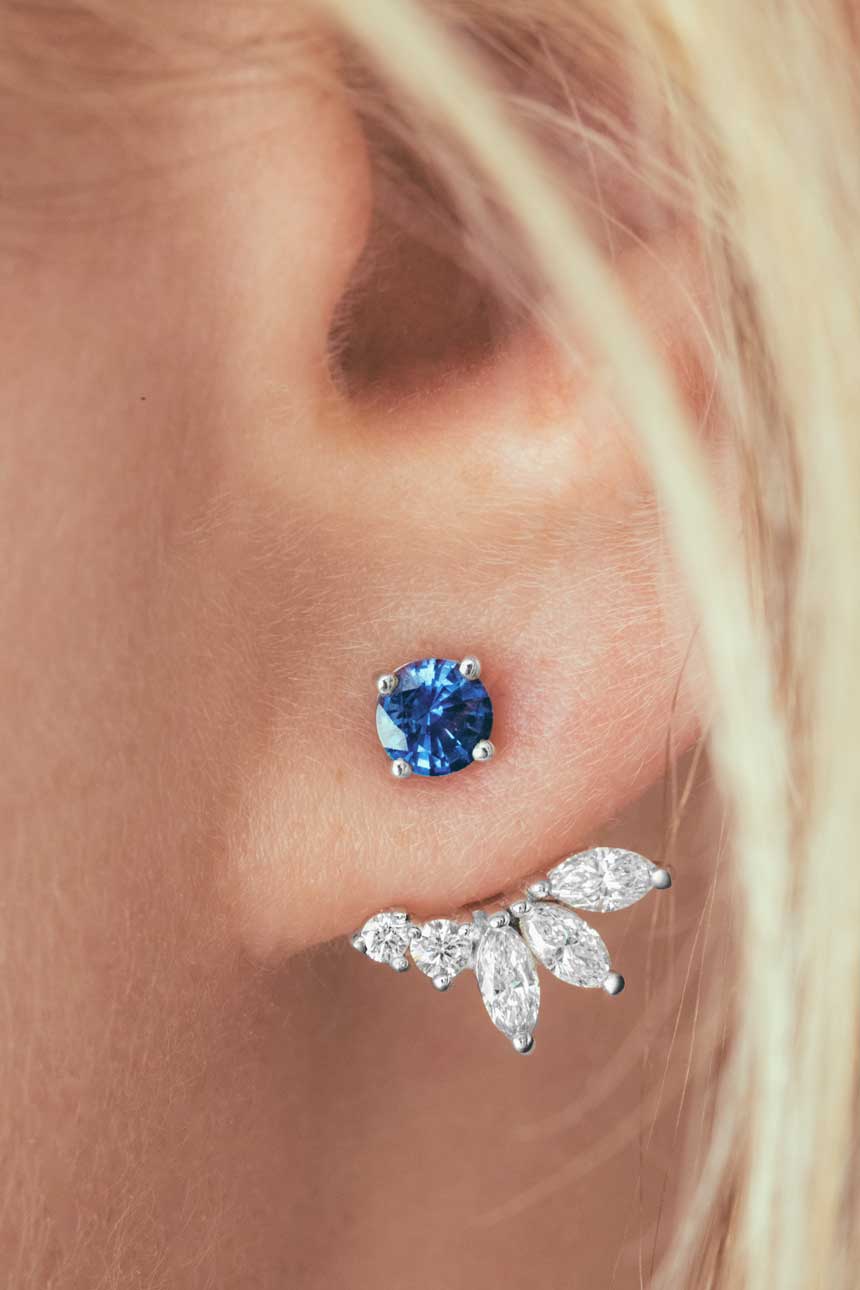
The main characteristics of sapphire
Sapphire is one of the four precious stones along with emerald, diamond and ruby. It belongs to the corundum family.
Corundum is a mineral species that has three main characteristics:
—— First, extreme strength
9/10 on the Mohs scale, sapphire is the third most resistant mineral on our planet after moissanite and the famous diamond! This means that no stone can scratch it except itself and its two predecessors.
This high resistance ensures that a piece of jewelry set with a sapphire will last a long time, which is one of the main reasons why this stone is often recommended for an engagement ring.
Did you know that?
Because of its high resistance - especially to scratches - sapphire is used in the manufacture of watch glass! Created in a laboratory, sapphire glass is synthetic but has the same properties as natural sapphire and is therefore 7 times more resistant than tempered steel.
—— Emblematic colors
One of the great characteristics of corundum is its wide variety of colours. The most famous are of course red (for ruby) and blue.
Ranging from light blue to a darker blue, sapphire has a wide range of shades. At Gemmyo, we offer sapphires from Thailand directly in our catalogue, recognisable by their rather dark royal blue colour.
How are these colours obtained?
Since its natural composition is colorless, it is paradoxically the presence of impurities that gives a sapphire its color. For blue, it is a mixture of iron and titanium oxide that gives this famous colour. Chromium oxide, on the other hand, will make a sapphire pink, for example.
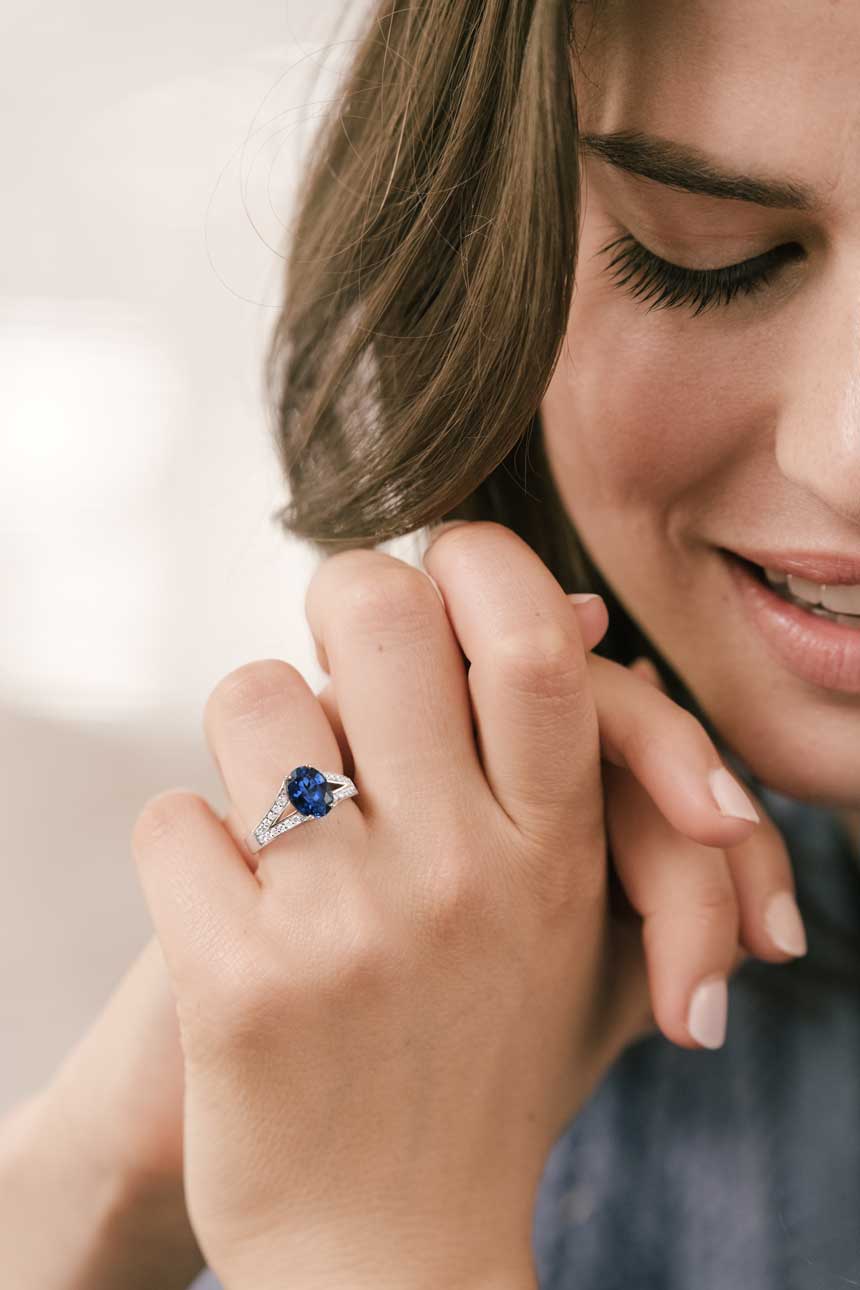
Did you know ?
The only colour that doesn't exist for a sapphire is red, because a red sapphire is just known as a ruby. Technically, gemologists forbid the use of the term "red sapphire", and prefer the term ruby!
—— Corundum is extremely heat resistant
A sapphire is a stone that is not very sensitive to thermal shocks and high temperatures. Its melting point is around 2000°C, a temperature you are unlikely to encounter!
In concrete terms, with a sapphire, there is no risk of putting your hand in an oven to recover a dish - unlike emerald for example.
Beyond these characteristics, sapphire is also famous for its high quality. What defines it?
The quality of a sapphire
—— AAA quality, the highest quality for a coloured stone.
Unlike diamonds, coloured stones do not have internationally recognised, standardised systems to compare them.
That said, the certification of a coloured stone - such as a sapphire - is just as rigorous as for a diamond and corresponds to three levels of quality:
-
A for medium and common quality.
-
AA for a rarer quality that is not especially used by large dealers but rather by small local lapidaries. It corresponds to a superior quality with very few defects and pronounced colors.
-
AAA the best quality for coloured stones. It corresponds to a total absence of defects, superior shine and pronounced and homogeneous colours.
How is this quality assessed for a sapphire?
Well, it is based directly on the universal 4Cs used for diamond certification! Namely :
-
Colour: whether it is natural or enhanced by treatment.
-
Weight: the number of carats of the stone.
-
Cut or faceting: the evaluation of the quality of the faceting of the stone and its shape.
-
Purity: the presence or absence of inclusions visible to the naked eye or x10 magnifying glass.
At Gemmyo, we certify all our coloured stonesr - including sapphire - to be AAA quality. This certification from our gemologists guarantees that you are choosing a perfectly cut, brilliant stone of the finest quality in circulation.
—— Our little extra: exceptional sapphires
You will certainly notice on some of our models, the possibility to choose an EXC sapphire, this acronym corresponding to exceptional.
An exceptional sapphire is a sapphire distinguished by our specialists for its colour, its purity and its extraordinary size. These sapphires represent less than 0.5% of the stones mined and are available in unique specimens depending on our arrivals.
Please note that all our exceptional sapphires are Ceylon sapphires, one of the most sought-after origins, and that you can choose them directly during your appointment in the boutique.
FAQs
—— "Are sapphires treated?"
The vast majority of natural coloured stones on the planet are heated.
What does this mean?
Heating a stone is a process that has been used since ancient times on coloured stones in order to maintain its colour, strengthen it or simply to make the stone more resistant. It is a process that does not harm the stone, on the contrary, it even does it good! So don't be afraid of it!
Contrary to popular belief, unheated stones are extremely rare and, if it is not stated or if there is not a specific certificate attesting to this, it is unlikely that a stone is unheated. If you are told that it is an unheated sapphire, beware unless you have a certificate from an independent laboratory. An unheated stone with a beautiful intensity of colour is so rare that its price is multiplied by 100 and is only used for extremely unique pieces.
Even if this process does not correspond to a specific treatment, it should not be confused with chemical treatments, which are controlled by the State because they denature the stone, such as irradiation, filling of cracks, impregnation and colouring.
Gemmyo sapphires are thus heated, which is a natural treatment, but we carefully control all our stones to avoid all other treatments!
—— "Can sapphires be certified by an international body?"
Yes, a sapphire - like all coloured stones - can be certified by an international organisation such as the famous GIA - Gemological Institute of America. However, this is extremely rare.
Why is this?
Because the certification of a coloured stone by an international laboratory is very expensive - up to 500 dollars for a stone - and therefore has a significant impact on its purchase price.
In order to guarantee you the fairest price and like most of the major jewelry houses, we at Gemmyo have chosen to offer you coloured stones certified by our teams of gemologists, whose speciality and core business it is
—— "Is a Ceylon sapphire of better quality?"
Contrary to what you might think, a Ceylon sapphire is not of a "better quality" than a sapphire from Thailand for example. It is simply a question of its origin, a region in Sri Lanka.
As with most coloured stones, the origins are a sign of a particular hue but not a sign of better quality.
A sapphire remains a sapphire regardless of its origin. Only its colour, intensity and reflections may vary and Ceylon sapphires are known to be lighter than their Thai cousins.
—— "Can I choose the colour of my sapphire?"
- For ordering on the website
When you choose a sapphire jewel on our website, our team of gemologists will choose the stone for you. We will do our best to match the colour of the stones available on the website.
However, if you have a preference for the colour of your sapphire, we strongly advise you to let us know at the time of your order! Our gemologists will then do their best to find the stone closest to your desire!
Please note: a colour is a very subjective notion and we cannot guarantee you 100% to obtain an extremely specific and precise hue. It also depends on the stones available at the time.
- For an order in a shop
When you place an order in one of our boutiques, we give you the opportunity to choose your sapphire directly on the spot!
This choice is possible for sapphires in the AAA quality catalogue and also for exceptional sapphires.
Please note that the stock of sapphires visible on site may be more or less limited depending on the stones available. This means that not all sizes and shapes of stones are available.
If you come to visit us specifically for this purpose, do not hesitate to tell us so when you request an appointment!
—— "What metal should be associated with sapphire?"
Its deep blue colour allows it to be associated with all colours. Precious metals such as white gold or platinum allow you to obtain a harmonious ensemble that gives the stone its full brilliance!
Combining it with yellow gold or rose gold creates an interesting and daring contrast.
Our advice: avoid black gold which will tend to darken the sapphire! Unless of course it is the desired effect to make it more discreet!
—— "What is the occasion for giving a sapphire?"
Very often chosen for engagement, it is also traditionally given to celebrate the 5th as well as the 16th wedding anniversary. Sapphire is also associated with the month of September and the zodiac sign of Libra.
As the stone of the month of September, sapphire is suitable for both men and women.A symbol of truth, this stone gives strength and loyalty to those who wear it.
Discover our sapphire jewelry.
More specifically, discover our sapphire engagement rings.
See all our precious stones.















